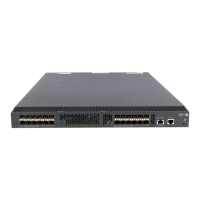29
Ste
Command
Remarks
2. Set a DSCP value for NTP
packets.
• IPv4 packets:
ntp-service dscp dscp-value
• IPv6 packets:
ntp-service ipv6 dscp
dscp-value
The defaults for a DSCP value:
• 48 for IPv4 NTP packets.
• 56 for IPv6 NTP packets.
Configuring the local clock as a reference source
Follow these guidelines when you configure the local clock as a reference source:
• Make sure the local clock can provide the time accuracy required for the network. After you
configure the local clock as a reference source, the local clock is synchronized, and can operate as
a time server to synchronize other devices in the network. If the local clock is incorrect, timing errors
occur.
• Before you configure this feature, adjust the local system time to make sure it is accurate.
To configure the local clock as a reference source:
Ste
Command
Remarks
1. Enter system view.
system-view N/A
2. Configure the local clock as a
reference source.
ntp-service refclock-master
[ ip-address ] [ stratum ]
By default, the device does not use
the local clock as a reference
source.
Displaying and maintaining NTP
Execute display commands in any view.
Task Command
Display information about IPv6 NTP associations. display ntp-service ipv6 sessions [ verbose ]
Display information about IPv4 NTP associations. display ntp-service sessions [ verbose ]
Display information about NTP service status. display ntp-service status
Display brief information about the NTP servers from
the local device back to the primary reference source.
display ntp-service trace
NTP client/server mode configuration example
Network requirements
As shown in Figure 9, the local clock of Device A is to be used as a reference source, with the stratum level
2. Device B operates in client mode and Device A is to be used as the NTP server for Device B.

